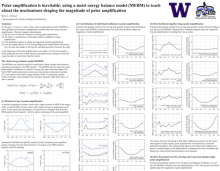Polar amplification is inevitable: using a moist energy balance model to teach about patterns of global warming
Kyle
Armour
University of Washington
Poster
Polar amplification has numerous causes. Positive radiative feedbacks at high latitudes (e.g., due to surface albedo and lapse rate changes) greatly amplify warming there relative to the tropics. But even in the absence of those feedbacks, polar amplification would still occur due to increased atmospheric latent heat transport to high latitudes under global warming. In addition, ocean heat uptake and transport shape warming patterns at the poles, and are a major cause of the asymmetry in warming between the Arctic and Antarctic.
The relative contributions of all these factors can be demonstrated fairly simply through the use of a moist energy balance model (MEBM) which takes as its input zonal-mean patterns of radiative forcing, ocean heat uptake, and radiative feedbacks, and predicts zonal-mean surface temperature change and atmospheric heat transport (partitioned into moist and dry components as well). For the past several years, I’ve been using the MEBM as a tool to teach graduate students and advanced undergraduate students about the interplay between all of the mechanisms of polar amplification including the relative roles of individual feedbacks and heat transport. A punchline is that polar amplification is inevitable – it is driven by positive polar feedbacks, but even in their absence, atmospheric heat transport would still cause the poles to warm more than the tropics. Here I demonstrate one of the lessons I use in my classes, and hope to inspire others to incorporate similar lessons in their teaching on this topic as well.
The relative contributions of all these factors can be demonstrated fairly simply through the use of a moist energy balance model (MEBM) which takes as its input zonal-mean patterns of radiative forcing, ocean heat uptake, and radiative feedbacks, and predicts zonal-mean surface temperature change and atmospheric heat transport (partitioned into moist and dry components as well). For the past several years, I’ve been using the MEBM as a tool to teach graduate students and advanced undergraduate students about the interplay between all of the mechanisms of polar amplification including the relative roles of individual feedbacks and heat transport. A punchline is that polar amplification is inevitable – it is driven by positive polar feedbacks, but even in their absence, atmospheric heat transport would still cause the poles to warm more than the tropics. Here I demonstrate one of the lessons I use in my classes, and hope to inspire others to incorporate similar lessons in their teaching on this topic as well.

armour-kyle-polar-poster.pdf
(2.79 MB)
